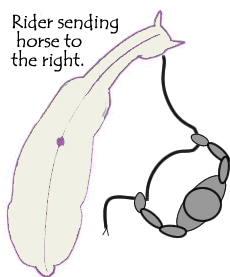Leading: Horse shall following willingly when lead, not crowd or lag behind, no rushing ahead or over-reacting to cues by jumping around. The Rider should have the Horse’s attention at all times, pulling, grazing, nudging the Judge or pushing the Rider is considered a fault. Excess rope shall be held in the non-lead hand, looped in figure 8 in your hand, and not coiled around your hand.
- The Horse can be lead with a halter and lead rope or the Rider can unclip the reins from the bit rings and correctly fasten them to the leading-ring of the halter or halter bridle combo. If using a lead rope the reins should be secured to the horn of a Western saddle, or appropriately secured (such as a carabineer on a saddle) if no saddle horn is available.
- A Rider ground handling his Horse through challenging terrain, over logs, through tight spaces shall secure a safe position prior to asking this Horse to negotiate the obstacle.
- If the Rider is instructed to lead the horse onto a narrow path (in-hand) the rider will give out enough lead for the horse to follow behind them at a safe distance.
- The Rider may choose to use their bridle and reins for in-hand obstacles, but Horse must be responsive and Rider’s cues soft.
Sending: Riders are also evaluated on their Horsemanship skills when asked to complete in-hand sending obstacles. The same rules apply to these obstacles as with leading.
- The Rider can execute an in-hand obstacle with the Horse in a bridle or halter & lead. Most Horses respond best to direction from their Rider with a rope halter & lead. A 12′ lead gives the Rider the best advantage when cueing a Horse in-hand. If an obstacle calls for a longer rope it will be provided at the obstacle.
- The Horse shall follow the Riders direction willingly when sent. The Horse can look and investigate footing but should not turn away from the desired path.
- Cuing the Horse with the ‘tail end’ of the lead is allowed.
- The Rider should face the Horse, point in the direction the Horse should go and cue with the lead. (see below)
- A Rider executing an in-hand obstacle with their Horse through challenging terrain, over logs, through tight spaces shall be in a safe position prior to asking this Horse to negotiate the obstacle.
- If the Rider is instructed to lead and send their Horse on a narrow path the Rider will give out enough lead for the Horse to follow behind them at a safe distance or send the Horse ahead and if room allows, have the Horse yield his hindquarters.
